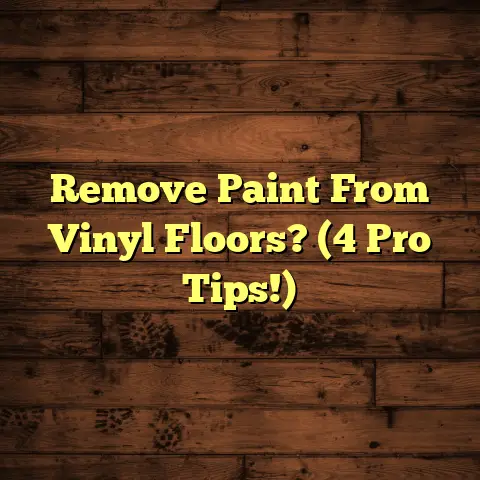Matching Existing Hardwood? (2 Things To Know First!)
Ever walked into a room with gorgeous hardwood floors and thought, “Wow, I want that!”?
I get it.
I’ve spent years as a flooring contractor, and I’ve seen firsthand how much beautiful hardwood can transform a space.
But what happens when you need to repair or extend those floors?
That’s where the challenge of matching existing hardwood comes in.
Imagine this: you’ve got a water-damaged section, a scratch from moving furniture, or maybe a pet accident that’s left its mark.
The question is: how do you make the repair seamless, so the new wood blends perfectly with the old?
It’s not as simple as picking a similar color.
It requires a bit of detective work and an understanding of what makes your existing hardwood unique.
Before you dive in, there are two crucial things you need to know.
And that’s exactly what I’m going to break down for you in this article.
Section 1: Understanding
Hardwood Variability
1. Wood Species and Grain Patterns
Okay, let’s talk wood.
Did you know there’s a whole world of hardwood species out there?
We’re talking oak, maple, cherry, walnut – the list goes on!
Each one has its own unique character, including color, grain patterns, and hardness.
Think of it like wine: a Cabernet Sauvignon is completely different from a Pinot Noir, right?
Hardwood is the same way.
Identifying the specific type of wood used in your existing flooring is the first step.
How do you figure it out?
Well, you can start by examining the grain.
Is it tight and uniform, or more open and pronounced?
What about the color?
Is it a warm reddish-brown, or a lighter, almost blonde shade?
Sometimes, it’s tricky to tell just by looking.
I’ve had clients send me pictures, and even then, it can be tough!
That’s where consulting a professional or using online resources can be a lifesaver.
There are even apps that can help you identify wood species based on a photo!
Once you’ve narrowed down the species, you need to consider the grain pattern.
This is where things get a bit more technical.
Different cuts of wood, like quarter-sawn versus plain-sawn, will have different grain patterns.
-
Plain-sawn: This is the most common cut, and it produces a wavy, cathedral-like grain pattern.
-
Quarter-sawn: This cut is more stable and has a tighter, more linear grain pattern.
Why does this matter?
Because if your existing floor is quarter-sawn oak, and you try to match it with plain-sawn oak, it’s going to look off, even if they’re the same species and color.
Pro Tip: Take a close-up photo of your existing floor and compare it to images of different grain patterns online.
This can help you determine the cut of wood used in your floor.
2. Aging and Patina
Now, let’s talk about something that a lot of people overlook: aging.
Hardwood floors aren’t like a brand-new car that stays pristine forever.
Over time, they change.
Exposure to sunlight, air, and daily wear and tear all affect the color and finish of hardwood.
This creates a natural patina, a sort of “seasoning” that gives older floors their unique character.
Think of it like a well-worn leather jacket.
It just looks better with age, right?
The same goes for hardwood.
Understanding the age of your existing flooring is crucial because new, unfinished wood will never look exactly the same as aged wood.
Older hardwood may have darkened or developed a unique luster that’s hard to replicate.
I remember one job where the client wanted to patch a section of their antique oak floor.
The new oak looked completely out of place because it was so much lighter and brighter than the existing floor.
We ended up having to stain and distress the new wood to match the aged appearance of the old floor.
So, how do you match that aged look?
Well, there are a few strategies you can use.
-
Staining: This is the most common way to darken new wood to match the color of aged wood.
-
Finishing: Using a tinted finish can also help to add warmth and depth to new wood.
-
Distressing: This involves physically damaging the new wood to mimic the wear and tear of aged wood.
This can include techniques like hand-scraping, wire-brushing, and even adding dents and scratches.
Example: I once used a combination of staining and distressing to match a section of 100-year-old heart pine flooring.
It was a challenging project, but the end result was seamless!
Real-World Data: According to the National Wood Flooring Association (NWFA), the average lifespan of a hardwood floor is 25-100 years, depending on the species, finish, and maintenance.
This means that even if you’re only patching a small section, you’re likely dealing with wood that’s already several years old, if not decades.
Section 2: Techniques for
Achieving a Perfect Match
1. Sampling and Testing
Alright, now that you understand the variables involved, let’s talk about how to actually achieve a perfect match.
The key here is sampling.
Don’t just walk into a flooring store, pick a board that looks close, and hope for the best.
That’s a recipe for disaster!
Instead, obtain samples of potential hardwood matches from local suppliers or manufacturers.
Most flooring stores will be happy to give you samples, and some may even let you borrow larger pieces to test at home.
Once you have your samples, it’s time to put them to the test.
Here’s a step-by-step process:
-
Placement: Place the samples next to your existing hardwood in various lighting conditions.
Natural light, artificial light, morning light, evening light – all of these will affect how the colors appear.
-
Observation: Observe the interaction between the new and old flooring.
Does the new wood look too light, too dark, too warm, or too cool?
Does the grain pattern clash with the existing floor?
-
Treatment: Experiment with stains and finishes.
This is where you can really fine-tune the match.
Apply different treatments to the samples and see how they affect the color and overall appearance.
DIY Tip: You can buy small sample sizes of stain at most hardware stores.
This is a great way to test different colors without committing to a full quart.
I always tell my clients to take their time with this step.
Don’t rush the process.
Live with the samples for a few days, observe them in different lighting conditions, and don’t be afraid to experiment.
The Role of Stains and Finishes:
Stains and finishes are your secret weapons when it comes to matching hardwood.
They can be used to adjust the color, sheen, and even the texture of the wood.
-
Stains: Stains penetrate the wood and change its color.
They come in a wide range of colors, from light and natural to dark and rich.
-
Finishes: Finishes protect the wood and provide a sheen.
They can be oil-based, water-based, or even wax-based.
The type of finish you use will affect the overall look and feel of the floor.
Example: Let’s say you find a hardwood sample that’s close to your existing floor, but it’s just a little too light.
You could try applying a stain that’s a shade darker to bring it closer to the desired color.
Or, if the sample is the right color but too shiny, you could try using a matte finish to tone it down.
2. Professional Consultation
vs. DIY Approaches
Okay, so you’ve done your research, you’ve collected your samples, and you’ve experimented with stains and finishes.
Now it’s time to decide whether you want to tackle this project yourself or hire a professional.
There are pros and cons to both approaches.
DIY Advantages:
-
Cost Savings: This is the biggest draw for most people.
Hiring a professional can be expensive, so doing it yourself can save you a significant amount of money.
-
Control: You have complete control over the process, from start to finish.
-
Satisfaction: There’s a certain sense of satisfaction that comes from completing a project yourself.
DIY Disadvantages:
-
Time Commitment: Matching hardwood can be a time-consuming process.
-
Skill Required: You need to have at least some basic woodworking skills to do it right.
-
Potential for Mistakes: If you make a mistake, it can be costly to fix.
Professional Advantages:
-
Expertise: Professionals have years of experience matching hardwood.
They know the ins and outs of different wood species, grain patterns, and finishes.
-
Efficiency: Professionals can complete the job much faster than you could on your own.
-
Guaranteed Results: Most professionals will guarantee their work, so you can be sure that you’ll get a good result.
Professional Disadvantages:
-
Cost: Hiring a professional can be expensive.
-
Less Control: You’ll have to relinquish some control over the process.
When is professional help particularly valuable?
-
Unique Wood Species: If you have a rare or unusual wood species, it may be difficult to find a match on your own.
-
Complex Grain Patterns: Matching complex grain patterns requires a high level of skill and experience.
-
Large Areas: If you’re patching a large area, it may be worth it to hire a professional to ensure a consistent result.
What to expect when hiring a professional:
-
Consultation: The professional will assess your existing floor and discuss your options.
-
Quote: The professional will provide you with a written quote outlining the cost of the project.
-
Timeline: The professional will give you an estimated timeline for completing the project.
DIY Tips:
If you decide to tackle the project yourself, here are a few tips to help you achieve the best possible match:
-
Rent the Right Tools: You’ll need a sander, a stain brush, a finish applicator, and other specialized tools.
Renting these tools can save you money compared to buying them.
-
Practice on Scrap Wood: Before you start working on your actual floor, practice your staining and finishing techniques on scrap wood.
-
Take Your Time: Don’t rush the process.
Work slowly and carefully, and pay attention to detail.
Story Time: I had a client who tried to match their hardwood floor themselves.
They ended up using the wrong type of stain, and the new wood looked completely different from the old wood.
They had to hire me to come in and fix their mistake, which ended up costing them more than if they had hired me in the first place!
Real-World Data: According to HomeAdvisor, the average cost to repair or replace hardwood flooring ranges from \$4 to \$8 per square foot.
This cost can vary depending on the type of wood, the complexity of the job, and the location.
Conclusion: A Harmonious Blend
Matching existing hardwood can be a challenging but rewarding project.
By understanding the unique characteristics of your flooring and employing the right techniques, you can restore the beauty of your space and maintain the integrity of your home’s aesthetic.
Remember, patience and attention to detail are key.
Whether you choose to consult a professional or tackle the project yourself, keep in mind that the goal is to create a seamless transition that allows your hardwood floors to radiate warmth and charm for years to come.
So, go out there and make those floors shine!





